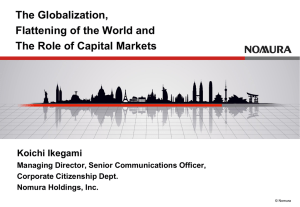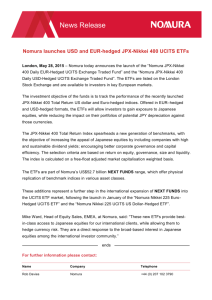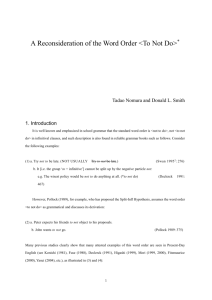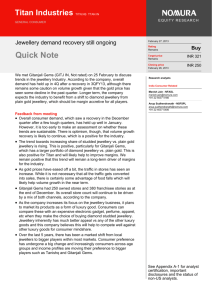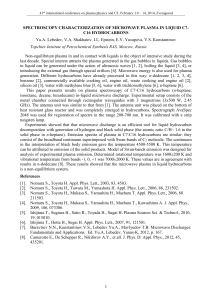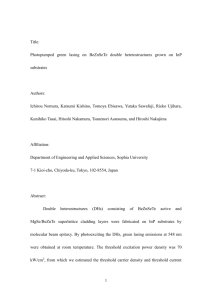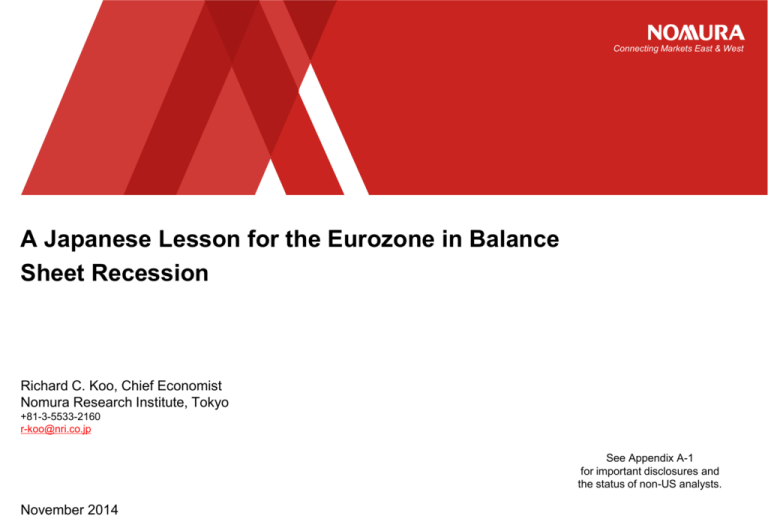
Connecting Markets East & West
A Japanese Lesson for the Eurozone in Balance
Sheet Recession
Richard C. Koo, Chief Economist
Nomura Research Institute, Tokyo
+81-3-5533-2160
r-koo@nri.co.jp
See Appendix A-1
for important disclosures and
the status of non-US analysts.
November 2014
Exhibit 1. Drastic Liquidity Injections Resulted in minimal
Increases in Money Supply and Credit (I): US
500
(Aug. 2008 =100, seasonally adjusted)
467
Monetary Base
450
Money Supply (M2)
400
Loans and Leases in Bank Credit
350
300
250
200
150
148
100
107
50
3.0
(%, yoy)
Consumer Spending
Deflator (core)
2.5
2.0
1.5
+1.48%
1.0
0.5
07/1
07/7
08/1
08/7
09/1
09/7
10/1
10/7
11/1
11/7
12/1
12/7
13/1
13/7
14/1
14/7
Note: Commercial bank loans and leases, adjustments f or discontinuities made by Nomura Research Institute.
Sources: Federal Reserve Board; US Department of Commerce
1
Exhibit 2. Drastic Liquidity Injections Resulted in minimal
Increases in Money Supply and Credit (II): Eurozone
200
(Aug. 2008 =100, seasonally adjusted)
190
Base Money
180
Money Supply (M3)
170
Credit to Euro Area Residents
160
150
140
131
130
120
110
111
98
100
90
80
2.2
2.0
1.8
1.6
1.4
1.2
1.0
0.8
0.6
(%, yoy)
CPI core
+0.7%
07/1
07/7
08/1
08/7
09/1
09/7
10/1
10/7
11/1
11/7
12/1
12/7
13/1
13/7
14/1
14/7
Note: Base money's f igures are seasonally adjusted by Nomura Research Institute.
Sources: European Central Bank; Eurostat
2
Exhibit 3. Drastic Liquidity Injections Resulted in minimal
Increases in Money Supply and Credit (III): UK
500
(Aug. 2008 =100, seasonally adjusted)
458
1
Reserve Balances + Notes & Coin
Money Supply (M4)
Bank Lending (M4)
450
400
350
300
Aug. 08'
250
200
150
117
86
100
50
6
5
4
3
2
1
0
(%, yoy)
CPI (ex. Indirect Taxes)
+1.2%
07/1
07/7
08/1
08/7
09/1
09/7
10/1
10/7
11/1
11/7
12/1
12/7
13/1
13/7
14/1
14/7
Notes: 1. Reserve balances data are seasonally unadjusted.
2. Money supply and bank lending data exclude intermmediate f inancial institutions.
Sources: Bank of England; Of f ice f or National Statistics, UK
3
Exhibit 4. Drastic Liquidity Injections Resulted in minimal
Increases in Money Supply and Credit (IV): Japan
700
(1990 Q1 = 100, seasonally adjusted)
Monetary Base
600
Quantitative
Easing
Quantitative and
Qualitative Easing
672
Money Supply (M2)
500
Earthquake
Bank Lending
400
Bubble Burst
300
200
189
100
1091
0
4
3
2
1
0
-1
-2
-3
(%, yoy)
+1.0%2
CPI Core
(ex. fresh food)
85 86 87 88 89 90 91 92 93 94 95 96 97 98 99 00 01 02 03 04 05 06 07 08 09 10 11 12 13 14
Notes: 1. Figures f or bank lending are seasonally adjusted by Nomura Research Institute.
2. Excluding the impact of consumption tax.
Source: Bank of Japan
4
Exhibit 5. The Cause of Breakdown in Monetary
Transmission: Bursting of Debt-Financed Bubbles
US House Prices Have Been Following the Japanese Experience
Futures
(US: Jan. 2000=100, Japan: Dec. 1985=100)
260
US: 10 Cities Composite Home Price Index
240
Composite
Index
Futures
Japan: Tokyo Area Condo Price1
220
200
180
160
140
120
Japan f alls of f
its f iscal clif f
(Apr. 1997)
100
80
Japan: Osaka Area Condo Price1
60
40
92
93
94
95
96
97
98
99
00
01
02
03
04
05
06
07
08
09
10
11
12
13
14
77
78
79
80
81
82
83
84
85
86
87
88
89
90
91
92
93
94
95
96
97
98
99
US
Japan
Notes: per m2, 5-month moving average. As of Nov. 3, 2014.
Sources: Bloomberg; Real Estate Economic Institute, Japan; S&P, S&P/Case-Shiller® Home Price Indices.
5
Exhibit 6. Europe also Experienced House Price Bubbles,
except Germany and Austria
(end of 1995 = 100)
550
514
525
500
Ireland
475
Greece
450
425
Spain
400
Germany
375
Austria (Vienna)
342
350
325
Ireland
283
300
303
275
Spain
211
Greece
207
Vienna
202
250
225
200
a symptom of
Eurozone crisis
90
175
150
125
Germany
110
100
75
91
92
93
94
95
96
97
98
99
00
01
02
03
04
05
06
07
08
09
10
11
12
13
14
Notes: 1. Ireland's f igures bef ore 2005 are existing house prices only.
2. Greece's f igures are f lats' prices in Athens and Thessaloniki.
Sources: Nomura Research Institute, calculated f rom Bank f or International Settlements data.
6
Exhibit 7. Japan’s Corporate De-leveraging with Zero
Interest Rates Lasted for over 10 Years
Funds Raised by Non-Financial Corporate Sector
(% Nominal GDP, 4Q Moving Average)
(%)
25
10
CD 3M rate
(right scale)
20
8
Borrowings from Financial Institutions (left scale)
15
6
Funds raised in Securities Markets (left scale)
10
4
5
2
0
0
-5
Debt-financed
bubble
(4 years)
Balance sheet
recession
(16 years)
-10
-2
-4
-15
-6
85 86 87 88 89 90 91 92 93 94 95 96 97 98 99 00 01 02 03 04 05 06 07 08 09 10 11 12 13
Sources: Bank of Japan; Cabinet Of f ice, Japan
7
Exhibit 8. Japan’s GDP Grew despite major Loss of Wealth
and Private Sector De-leveraging
(Sep. 1990 = 100)
(Sep.1990=100, seasonally adjusted)
140
130
Nominal GDP (Right Scale)
Real GDP
(Right Scale)
120
115
Reported Fiscal Multiplier
100
Actual
Fiscal
Multiplier
Likely GDP Path
w/o Government Action
80
85
60
70
40
55
Last seen in 1973
20
40
Land Price Index in Six Major Cities
(Commercial, Left Scale)
0
25
80
82
84
86
88
90
92
94
96
98
00
02
04
06
Cumulative
90-05 GDP
Supported by
Government
Action:
~ ¥2000 trillion
100
08
10
12
down
87%
Cumulative
Loss of
Wealth on
Shares and
Real Estate
~ ¥1500 trillion
14
Sources: Cabinet Of f ice,Japan; Japan Real Estate Institute
8
Exhibit 9. Japan’s Challenge:
Get Businesses to Borrow Money
Financial Surplus or Deficit by Sector
(as a ratio to nominal GDP, %)
15
(Financial Surplus) Households
12
9
Rest of
the World
6
Private Sector
Savings:
5.72% of GDP
3
0
-3
-6
-9
General Government
Corporate Sector
-12
(Non-Financial Sector +
Financial Sector)
Global
Financial
Crisis
Balance Sheet Recession
-15
(Financial Deficit)
-18
81
83
85
87
89
91
93
95
97
99
01
03
05
07
09
11
13
Note: All entries are f our-quarter moving averages. For the latest f igures, f our-quarter averages ending in 2014 Q2 are used.
Sources: Bank of Japan, Flow of Funds Accounts, and Government of Japan, Cabinet Of f ice, National Accounts
9
Exhibit 10. US in Balance Sheet Recession: US Private
Sector Saved on Average 5% of GDP since 2008 Q4
Financial Surplus or Deficit by Sector
(as a ratio to nominal GDP, %, quarterly)
10
Households
(Financial Surplus)
Rest of the World
5
2014 Q2
Private Sector
Savings:
3.42% of GDP
0
-5
-10
General
Government
Corporate Sector
(Non-Financial Sector +
Financial Sector)
IT Bubble
(Financial Deficit)
Housing
Bubble
-15
85 86 87 88 89 90 91 92 93 94 95 96 97 98 99 00 01 02 03 04 05 06 07 08 09 10 11 12 13 14
Note: All entries are f our-quarter moving averages. For the latest f igures, f our-quarter averages ending in 2014 Q2 are used.
Sources: FRB, US Department of Commerce
10
Exhibit 11. Europe in Balance Sheet Recession, but Maastricht Treaty
cannot Handle Private Sector Savings far more than 3% of GDP
(as a ratio to nominal GDP, %)
30
(Financial Surplus)
Greece
Spain
Ireland
Portugal
Italy
25
20
15
2014 1Q
Private
Sector
Savings
Ireland: 10.20% >
Greece: 9.90% <
Spain:
7.48% >
Portugal: 7.01% >
Italy:
5.97% >
10
5
0
2013
Budget
Deficits
5.7%
12.2%
6.8%
4.9%
2.8%
-5
-10
Balance Sheet
Recession
Bubble
-15
(Financial Deficit)
-20
03
04
05
06
07
08
09
10
11
12
13
14
Notes: 1. Private Sector = Household Sector + Non-Financial Corporate Sector + Financial Sector
2. All entries are f our-quarter moving averages. For the latest f igures, f our-quarter averages ending in 2014 1Q (only Spain and
Portugal, 2014 2Q) are used. Budget def icits in Euro area in 2013 are f rom Oct. 21, 2014 release by Eurostat.
Sources: Bank of Greece, Banco de España, National Statistics Institute, Spain, The Central Bank of Ireland, Central Statistics
Of f ice Ireland, Banco de Portugal, Banca d'Italia and Italian National Institute of Statistics
11
Exhibit 12. Peripheral Eurozone Bond Yields Jumped
because of De-stabilizing Capital Flows
(%)
20
18
Japan
16
Eurozone crisis
UK
US
14
Spain
12
Portugal
Italy
10
8
6
4
2
0
2007
2008
2009
2010
2011
2012
2013
2014
Note: As of Nov. 3, 2014.
Source: Bloomberg
12
Exhibit 13. The Collapse of Neuer Markt in 2001 Pushed
German Economy into Balance Sheet Recession
(Dec. 31, 1997 = 1000)
10000
9694.07
9000
8000
7000
-97%
6000
5000
4000
3000
TecDAX
2000
1242.32
1000
0
1998
306.32
1999
2000
2001
2002
2003
2004
2005
2006
2007
2008
2009
2010
2011
2012
2013
2014
Source: Bloomberg As of Oct. 31, 2014
13
Exhibit 14. German Private Sector Refused to Borrow
Money after the Dotcom Bubble
Financial Surplus or Deficit by Sector
(as a ratio to nominal GDP, %, seasonally adjusted)
12
(Financial Surplus)
9
German Private Sector
Savings 13.4% of GDP
Dotcom Bubble
Households
6
3
0
-3
-6
General
Government
-9
Balance Sheet
Recession
Corporate Sector
(Non-Financial Sector + Financial Sector)
-12
Rest of the World
(Financial Deficit)
-15
92
93
94
95
96
97
98
99
00
01
02
03
04
05
06
07
08
09
10
11
12
13
14
Notes: The assumption of Treuhand agency's debt by the Redemption Fund f or Inherited Liabilities in 1995 is adjusted.
All entries are f our-quarter moving averages. For the latest f igures, f our-quarter averages ending in 2014 Q1 are used.
Source: Nomura Research Institute, based on the data of Bundesbank and Eurostat
14
Exhibit 15. German Households Stopped Borrowing
altogether after the Dotcom bubble
(as a ratio to nominal GDP, %, inverted, seasonally adjusted)
(as a ratio to nominal GDP, %, seasonally adjusted)
12
-12
left scale
Financial Assets
10
left scale
Collapse of
the Dotcom
Bubble
8
Financial
Surplus/Deficit
-10
-8
6
-6
4
-4
2
-2
0
0
-2
2
-4
4
The reason for German
house prices falling
noted on page 6
-6
Financial Liabilities right scale
6
-8
8
91
92
93
94
95
96
97
98
99
00
01
02
03
04
05
06
07
08
09
10
11
12
13
14
Note: Seasonal adjustments by Nomura Research Institute. Latest f igures are f or 2014 Q1.
Sources: Nomura Research Institute, based on f low of f unds data f rom Bundesbank and Eurostat
15
Exhibit 16. Spanish Households Increased Borrowings
after the Dotcom Bubble: Now They Are Deleveraging
(as a ratio to nominal GDP, %, seasonally adjusted)
(as a ratio to nominal GDP, %, inverted, seasonally adjusted)
20
-20
left scale
16
Collapse of the Dotcom Bubble
Financial
Assets
left scale
-16
Financial
Surplus/Deficit
12
-12
8
-8
4
-4
0
0
-4
4
-8
8
-12
12
Financial Liabilities right scale
-16
16
95
96
97
98
99
00
01
02
03
04
05
06
07
08
09
10
11
12
13
14
Notes: Seasonal adjustments by Nomura Research Institute. Latest f igures are f or 2014 Q2.
Sources: Nomura Research Institute, based on f low of f unds data f rom Banco de España and National Statistics Institute, Spain
16
Exhibit 17. Irish Households Increased Borrowings after
the Dotcom Bubble: Now They Are Deleveraging
(as a ratio to nominal GDP, %, seasonally adjusted)
(as a ratio to nominal GDP, %, inverted seasonally adjusted)
20
-20
left scale
Financial Assets
left scale
15
Financial
Surplus/Deficit
-15
10
-10
5
-5
0
0
-5
5
-10
10
-15
Financial
Liabilities
Collapse
of the
Dotcom
Bubble
-20
15
right scale
20
-25
25
02
03
04
05
06
07
08
09
10
11
12
13
14
Notes: Seasonal adjustments by Nomura Research Institute. Latest f igures are f or 2014 Q1.
Source: Nomura Research Institute, based on f low of f unds data f rom Central Bank of Ireland and Central Statistics Of f ice, Ireland
17
Exhibit 18. German-Eurozone (ex. Germany) Competitiveness
Gap Has Macro (50.2%) and Micro (49.8%) Factors
(ULC = Unit Labor Cost)
(1Q 2000 = 100, Seasonally Adjusted)
230
220
217.0
Eurozone M3
(ex. Germany)
210
200
Monetary
Source of
Competitiveness
Gap
Hypothetical Eurozone ULC (ex. Germany)
if its M3 growth was the same as in
Germany*
190
180
Eurozone ULC
(ex. Germany)
170
160
156.0
German ULC
150
German M3
140
129.9
130
115.2
120
50.2%: Macro-Monetary Effect
49.8%: German Labor
Reform Effect
110
100.6
100
90
00
01
02
03
04
05
06
07
08
09
10
11
12
Note: * Parameters obtained f rom the regression result on Eurozone ULC (ex. Germany) on Eurozone M3 (ex. Germany),
log(Eurozone ULC (ex.Germany)) = 3.155506 + log(Eurozone M3 (ex.Germany)) x 0.318227, applied to German M3
data indexed to 1Q 2000 = 100.
Sources: Nomura Research Institute, based on ECB, Eurostat and Deutsche Bundesbank data
18
Exhibit 19. Germany Recovered from Post-Dotcom Balance
Sheet Recession by Exporting to other Eurozone Countries
German Balance of Trade
(€mn, seasonally adjusted)
12000
Eurozone
driven by Eurozone
housing bubble
10000
8000
6000
US
driven by
weaker Euro
4000
2000
0
-2000
Asia
-4000
95
96
97
98
99
00
01
02
03
04
05
06
07
08
09
10
11
12
13
14
Source: Deutsche Bundesbank
19
Exhibit 20. Two Modifications to Euro Requiring No German
Money Are Sufficient to Resurrect Eurozone Economies
Two Structural Deficiencies of the Eurozone
(1)
(2)
Maastricht Treaty restricted
fiscal stimulus needed to fight
balance sheet recessions
Procyclical and destabilizing
capital flows between gov.
bond markets
Countries suffering from
balance sheet recessions fall
into deflationary spirals, while
excessive easings by the ECB
create bubbles elsewhere
Excessively low gov. bond
yields during bubbles
Excessively high gov. bond
yields during balance sheet
recessions
Allow countries in balance
sheet recessions to implement
sufficient fiscal stimulus with
blessings from the Troika
Introduce different risk weights
for holdings of domestic vs
foreign gov. bonds to keep
domestic savings at home
Problem
Solution
20
Exhibit 21. Contrast Between Yin and Yang Phases of
Economic Cycle for Eurozone
Textbook Economy
"Yang"
Balance Sheet Recession
"Yin"
1) Fundamental driver
Adam Smith's "invisible hand"
Fallacy of composition
2) Private financial condition
Assets > Liabilities
Assets < Liabilities
3) Behavioral principle
Profit maximization
Debt minimization
4) Outcome
Greatest good for greatest number
Depression if left unattended
5) Monetary policy
Effective
Ineffective (liquidity trap)
6) Fiscal policy
Counterproductive (crowding-out)
Effective
7) Prices
Inflationary
Deflationary
8) Interest rates
Normal
Very low
9) Savings
Virtue
Vice (paradox of thrift)
a) Localized
Quick NPL disposal
Pursue accountability
Normal NPL disposal
Pursue accountability
b) Systemic
Slow NPL disposal
Fat spread
Slow NPL disposal
Gov. capital injection
Stability and growth enhancing
Instability and depression inducing
10) Remedy for
Banking Crisis
11) Maastricht 3% gov. deficit rule
Source: Based on Richard Koo, The Holy Grail of Macroeconomics: Lessons from Japan’s Great Recession ,
John Wiley & Sons, Singapore, 2008, p.176
21
Appendix A-1
Any Authors named on this report are Research Analysts unless otherwise indicated
Important Disclosures
Online availability of research and conflict-of-interest disclosures
Nomura research is available on www.nomuranow.com/research, Bloomberg, Capital IQ, Factset, MarkitHub, Reuters and ThomsonOne.
Important disclosures may be read at http://go.nomuranow.com/research/globalresearchportal/pages/disclosures/disclosures.aspx or requested from Nomura
Securities International, Inc., on 1-877-865-5752. If you have any difficulties with the website, please email grpsupport@nomura.com for help.
The analysts responsible for preparing this report have received compensation based upon various factors including the firm's total revenues, a portion of which is
generated by Investment Banking activities. Unless otherwise noted, the non-US analysts listed at the front of this report are not registered/qualified as research
analysts under FINRA/NYSE rules, may not be associated persons of NSI, and may not be subject to FINRA Rule 2711 and NYSE Rule 472 restrictions on
communications with covered companies, public appearances, and trading securities held by a research analyst account.
Nomura Global Financial Products Inc. (“NGFP”) Nomura Derivative Products Inc. (“NDPI”) and Nomura International plc. (“NIplc”) are registered with the
Commodities Futures Trading Commission and the National Futures Association (NFA) as swap dealers. NGFP, NDPI, and NIplc are generally engaged in the trading
of swaps and other derivative products, any of which may be the subject of this report.
Any authors named in this report are research analysts unless otherwise indicated. Industry Specialists identified in some Nomura International plc research reports
are employees within the Firm who are responsible for the sales and trading effort in the sector for which they have coverage. Industry Specialists do not contribute in
any manner to the content of research reports in which their names appear.
Disclaimers
This document contains material that has been prepared by the Nomura entity identified at the top or bottom of page 1 herein, if any, and/or, with the sole or joint
contributions of one or more Nomura entities whose employees and their respective affiliations are specified on page 1 herein or identified elsewhere in the document.
The term "Nomura Group" used herein refers to Nomura Holdings, Inc. or any of its affiliates or subsidiaries and may refer to one or more Nomura Group companies
including: Nomura Securities Co., Ltd. ('NSC') Tokyo, Japan; Nomura International plc ('NIplc'), UK; Nomura Securities International, Inc. ('NSI'), New York, US;
Nomura International (Hong Kong) Ltd. (‘NIHK’), Hong Kong; Nomura Financial Investment (Korea) Co., Ltd. (‘NFIK’), Korea (Information on Nomura analysts
registered with the Korea Financial Investment Association ('KOFIA') can be found on the KOFIA Intranet at http://dis.kofia.or.kr); Nomura Singapore Ltd. (‘NSL’),
Singapore (Registration number 197201440E, regulated by the Monetary Authority of Singapore); Nomura Australia Ltd. (‘NAL’), Australia (ABN 48 003 032 513),
regulated by the Australian Securities and Investment Commission ('ASIC') and holder of an Australian financial services licence number 246412; P.T. Nomura
Indonesia (‘PTNI’), Indonesia; Nomura Securities Malaysia Sdn. Bhd. (‘NSM’), Malaysia; NIHK, Taipei Branch (‘NITB’), Taiwan; Nomura Financial Advisory and
Securities (India) Private Limited (‘NFASL’), Mumbai, India (Registered Address: Ceejay House, Level 11, Plot F, Shivsagar Estate, Dr. Annie Besant Road, Worli,
Mumbai- 400 018, India; Tel: +91 22 4037 4037, Fax: +91 22 4037 4111; CIN No : U74140MH2007PTC169116, SEBI Registration No: BSE INB011299030, NSE
INB231299034, INF231299034, INE 231299034, MCX: INE261299034) and NIplc, Madrid Branch (‘NIplc, Madrid’). ‘CNS Thailand’ next to an analyst’s name on the
front page of a research report indicates that the analyst is employed by Capital Nomura Securities Public Company Limited (‘CNS’) to provide research assistance
services to NSL under a Research Assistance Agreement. CNS is not a Nomura entity.
22
THIS MATERIAL IS: (I) FOR YOUR PRIVATE INFORMATION, AND WE ARE NOT SOLICITING ANY ACTION BASED UPON IT; (II) NOT TO BE CONSTRUED AS
AN OFFER TO SELL OR A SOLICITATION OF AN OFFER TO BUY ANY SECURITY IN ANY JURISDICTION WHERE SUCH OFFER OR SOLICITATION WOULD
BE ILLEGAL; AND (III) BASED UPON INFORMATION FROM SOURCES THAT WE CONSIDER RELIABLE, BUT HAS NOT BEEN INDEPENDENTLY VERIFIED BY
NOMURA GROUP.
Nomura Group does not warrant or represent that the document is accurate, complete, reliable, fit for any particular purpose or merchantable and does not accept
liability for any act (or decision not to act) resulting from use of this document and related data. To the maximum extent permissible all warranties and other
assurances by Nomura group are hereby excluded and Nomura Group shall have no liability for the use, misuse, or distribution of this information.
Opinions or estimates expressed are current opinions as of the original publication date appearing on this material and the information, including the opinions and
estimates contained herein, are subject to change without notice. Nomura Group is under no duty to update this document. Any comments or statements made herein
are those of the author(s) and may differ from views held by other parties within Nomura Group. Clients should consider whether any advice or recommendation in this
report is suitable for their particular circumstances and, if appropriate, seek professional advice, including tax advice. Nomura Group does not provide tax advice.
Nomura Group, and/or its officers, directors and employees, may, to the extent permitted by applicable law and/or regulation, deal as principal, agent, or otherwise, or
have long or short positions in, or buy or sell, the securities, commodities or instruments, or options or other derivative instruments based thereon, of issuers or
securities mentioned herein. Nomura Group companies may also act as market maker or liquidity provider (within the meaning of applicable regulations in the UK) in
the financial instruments of the issuer. Where the activity of market maker is carried out in accordance with the definition given to it by specific laws and regulations of
the US or other jurisdictions, this will be separately disclosed within the specific issuer disclosures.
This document may contain information obtained from third parties, including ratings from credit ratings agencies such as Standard & Poor’s. Reproduction and
distribution of third party content in any form is prohibited except with the prior written permission of the related third party. Third party content providers do not
guarantee the accuracy, completeness, timeliness or availability of any information, including ratings, and are not responsible for any errors or omissions (negligent or
otherwise), regardless of the cause, or for the results obtained from the use of such content. Third party content providers give no express or implied warranties,
including, but not limited to, any warranties of merchantability or fitness for a particular purpose or use. Third party content providers shall not be liable for any direct,
indirect, incidental, exemplary, compensatory, punitive, special or consequential damages, costs, expenses, legal fees, or losses (including lost income or profits and
opportunity costs) in connection with any use of their content, including ratings. Credit ratings are statements of opinions and are not statements of fact or
recommendations to purchase hold or sell securities. They do not address the suitability of securities or the suitability of securities for investment purposes, and should
not be relied on as investment advice.
Any MSCI sourced information in this document is the exclusive property of MSCI Inc. (‘MSCI’). Without prior written permission of MSCI, this information and any
other MSCI intellectual property may not be reproduced, re-disseminated or used to create any financial products, including any indices. This information is provided
on an "as is" basis. The user assumes the entire risk of any use made of this information. MSCI, its affiliates and any third party involved in, or related to, computing or
compiling the information hereby expressly disclaim all warranties of originality, accuracy, completeness, merchantability or fitness for a particular purpose with
respect to any of this information. Without limiting any of the foregoing, in no event shall MSCI, any of its affiliates or any third party involved in, or related to,
computing or compiling the information have any liability for any damages of any kind. MSCI and the MSCI indexes are services marks of MSCI and its affiliates.
23
Russell/Nomura Japan Equity Indexes are protected by certain intellectual property rights of Nomura Securities Co., Ltd. and Russell Investments. Nomura Securities
Co., Ltd. and Russell Investments do not guarantee the accuracy, completeness, reliability, or usefulness thereof and do not account for business activities and
services that any index user and its affiliates undertake with the use of the Indexes.
Investors should consider this document as only a single factor in making their investment decision and, as such, the report should not be viewed as identifying or
suggesting all risks, direct or indirect, that may be associated with any investment decision. Nomura Group produces a number of different types of research product
including, among others, fundamental analysis, quantitative analysis and short term trading ideas; recommendations contained in one type of research product may
differ from recommendations contained in other types of research product, whether as a result of differing time horizons, methodologies or otherwise. Nomura Group
publishes research product in a number of different ways including the posting of product on Nomura Group portals and/or distribution directly to clients. Different
groups of clients may receive different products and services from the research department depending on their individual requirements. Clients outside of the US may
access the Nomura Research Trading Ideas platform (Retina) at http://go.nomuranow.com/equities/tradingideas/retina/
Figures presented herein may refer to past performance or simulations based on past performance which are not reliable indicators of future performance. Where the
information contains an indication of future performance, such forecasts may not be a reliable indicator of future performance. Moreover, simulations are based on
models and simplifying assumptions which may oversimplify and not reflect the future distribution of returns.
Certain securities are subject to fluctuations in exchange rates that could have an adverse effect on the value or price of, or income derived from, the investment.
The securities described herein may not have been registered under the US Securities Act of 1933 (the ‘1933 Act’), and, in such case, may not be offered or sold in the
US or to US persons unless they have been registered under the 1933 Act, or except in compliance with an exemption from the registration requirements of the 1933
Act. Unless governing law permits otherwise, any transaction should be executed via a Nomura entity in your home jurisdiction.
This document has been approved for distribution in the UK and European Economic Area as investment research by NIplc. NIplc is authorised by the Prudential
Regulation Authority and regulated by the Financial Conduct Authority and the Prudential Regulation Authority. NIplc is a member of the London Stock Exchange. This
document does not constitute a personal recommendation within the meaning of applicable regulations in the UK, or take into account the particular investment
objectives, financial situations, or needs of individual investors. This document is intended only for investors who are ‘eligible counterparties’ or ‘professional clients’ for
the purposes of applicable regulations in the UK, and may not, therefore, be redistributed to persons who are ‘retail clients’ for such purposes. This document has
been approved by NIHK, which is regulated by the Hong Kong Securities and Futures Commission, for distribution in Hong Kong by NIHK. This document has been
approved for distribution in Australia by NAL, which is authorized and regulated in Australia by the ASIC. This document has also been approved for distribution in
Malaysia by NSM. In Singapore, this document has been distributed by NSL. NSL accepts legal responsibility for the content of this document, where it concerns
securities, futures and foreign exchange, issued by their foreign affiliates in respect of recipients who are not accredited, expert or institutional investors as defined by
the Securities and Futures Act (Chapter 289). Recipients of this document in Singapore should contact NSL in respect of matters arising from, or in connection with,
this document. Unless prohibited by the provisions of Regulation S of the 1933 Act, this material is distributed in the US, by NSI, a US-registered broker-dealer, which
accepts responsibility for its contents in accordance with the provisions of Rule 15a-6, under the US Securities Exchange Act of 1934.
24
This document has not been approved for distribution to persons other than ‘Authorised Persons’, ‘Exempt Persons’ or ‘Institutions’ (as defined by the Capital Markets
Authority) in the Kingdom of Saudi Arabia (‘Saudi Arabia’) or 'professional clients' (as defined by the Dubai Financial Services Authority) in the United Arab Emirates
(‘UAE’) or a ‘Market Counterparty’ or ‘Business Customers’ (as defined by the Qatar Financial Centre Regulatory Authority) in the State of Qatar (‘Qatar’) by Nomura
Saudi Arabia, NIplc or any other member of Nomura Group, as the case may be. Neither this document nor any copy thereof may be taken or transmitted or distributed,
directly or indirectly, by any person other than those authorised to do so into Saudi Arabia or in the UAE or in Qatar or to any person other than ‘Authorised Persons’,
‘Exempt Persons’ or ‘Institutions’ located in Saudi Arabia or 'professional clients' in the UAE or a ‘Market Counterparty’ or ‘Business Customers’ in Qatar . By accepting
to receive this document, you represent that you are not located in Saudi Arabia or that you are an ‘Authorised Person’, an ‘Exempt Person’ or an ‘Institution’ in Saudi
Arabia or that you are a 'professional client' in the UAE or a ‘Market Counterparty’ or ‘Business Customers’ in Qatar and agree to comply with these restrictions. Any
failure to comply with these restrictions may constitute a violation of the laws of the UAE or Saudi Arabia or Qatar.
NO PART OF THIS MATERIAL MAY BE (I) COPIED, PHOTOCOPIED, OR DUPLICATED IN ANY FORM, BY ANY MEANS; OR (II) REDISTRIBUTED WITHOUT
THE PRIOR WRITTEN CONSENT OF A MEMBER OF NOMURA GROUP. If this document has been distributed by electronic transmission, such as e-mail, then
such transmission cannot be guaranteed to be secure or error-free as information could be intercepted, corrupted, lost, destroyed, arrive late or incomplete, or contain
viruses. The sender therefore does not accept liability for any errors or omissions in the contents of this document, which may arise as a result of electronic
transmission. If verification is required, please request a hard-copy version.
Disclaimers required in Japan
Investors in the financial products offered by Nomura Securities may incur fees and commissions specific to those products (for example, transactions involving
Japanese equities are subject to a sales commission of up to 1.404% on a tax-inclusive basis of the transaction amount or a commission of ¥2,808 for transactions of
¥200,000 or less, while transactions involving investment trusts are subject to various fees, such as commissions at the time of purchase and asset management fees
(trust fees), specific to each investment trust). In addition, all products carry the risk of losses owing to price fluctuations or other factors. Fees and risks vary by
product. Please thoroughly read the written materials provided, such as documents delivered before making a contract, listed securities documents, or prospectuses.
Nomura Securities Co., Ltd.
Financial instruments firm registered with the Kanto Local Finance Bureau (registration No. 142)
Member associations: Japan Securities Dealers Association; Japan Investment Advisers Association; The Financial Futures Association of Japan; and Type II
Financial Instruments Firms Association.
Nomura Group manages conflicts with respect to the production of research through its compliance policies and procedures (including, but not limited to, Conflicts of
Interest, Chinese Wall and Confidentiality policies) as well as through the maintenance of Chinese walls and employee training.
Additional information is available upon request and disclosure information is available at the Nomura Disclosure web page:
http://go.nomuranow.com/research/globalresearchportal/pages/disclosures/disclosures.aspx
Copyright © 2014 Nomura Securities Co., Ltd.. All rights reserved.
25

